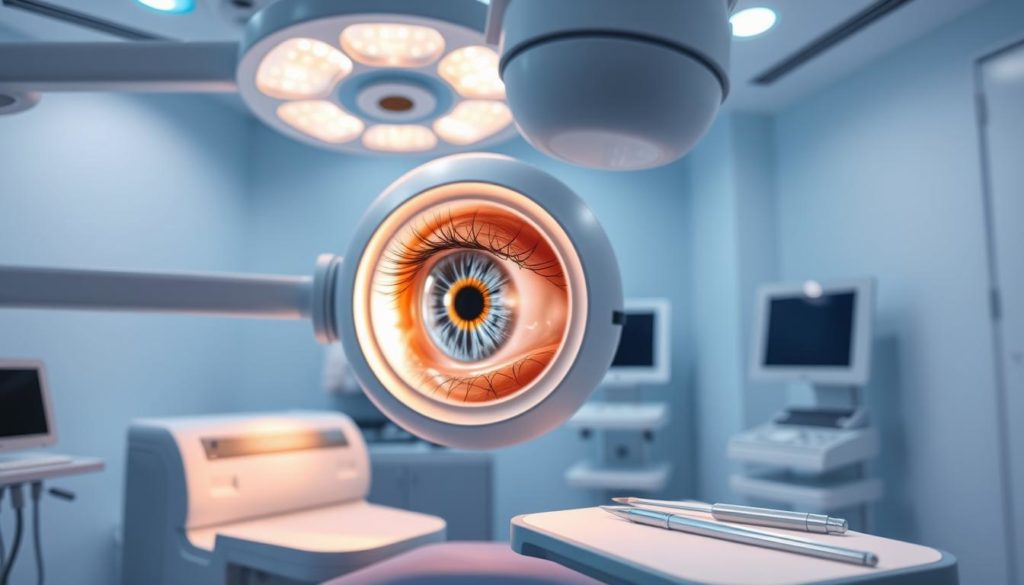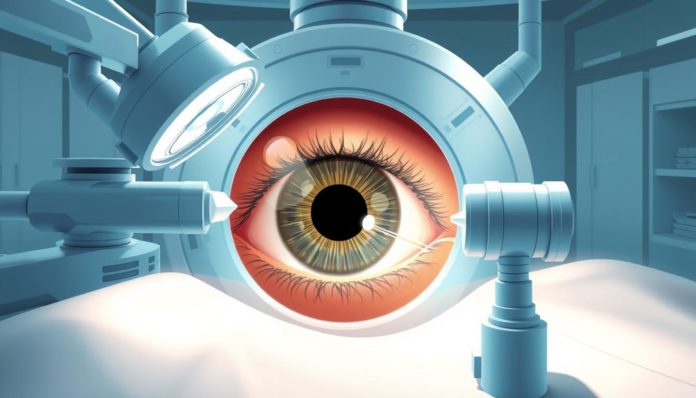Did you know over 30 million people worldwide have had laser vision correction? Many have chosen SMILE eye surgery. This procedure is less invasive than traditional methods. If you’re looking into SMILE Eye Surgery, this guide will help you understand its advantages and the process.
SMILE stands for Small Incision Lenticule Extraction. It’s becoming a top choice over LASIK, offering precision and fast recovery. This guide will explain how it works, its benefits, and the recovery process.
We’ll also compare SMILE with LASIK, talk about risks, and share patient testimonials. By the end, you’ll know if SMILE eye surgery is for you.
Introduction to SMILE Eye Surgery
SMILE, or Small Incision Lenticule Extraction, is a new vision correction surgery. It’s different from LASIK because it’s less invasive. This means you can heal faster and face fewer problems.

SMILE has many advantages. It doesn’t involve a flap on the cornea, which lowers the risk of complications. The surgery makes a small cut to remove a tiny piece of tissue. This reshapes your cornea and fixes your vision.
It’s important to learn about SMILE to see if it’s right for you. Many people choose SMILE because it’s precise and has less chance of dry eye. Dry eye is a common issue with other surgeries.
The world of vision correction has changed with SMILE. It’s a comfortable and quick way to see better without glasses or contacts.
Next, we’ll explore what SMILE Eye Surgery is all about. We’ll look at the procedure step by step and what you can expect.
What Is SMILE Eye Surgery?
SMILE Eye Surgery is short for Small Incision Lenticule Extraction. It’s a new, less invasive laser surgery for fixing nearsightedness and astigmatism. It works by removing a small part of the cornea through a small cut, reshaping it to better your vision.
This surgery is a big step forward because it combines the best of LASIK and PRK without their downsides. Unlike old laser surgeries, SMILE doesn’t need to cut the cornea open. This makes it safer and cuts down on dry eye problems after surgery.

SMILE is for people over 22 with stable vision for at least a year. It’s a permanent fix for those tired of glasses or contacts. It’s especially good for athletes and those who are always on the move because it heals fast and doesn’t mess up your daily life.
In the U.S., SMILE is getting more popular because it’s precise and heals quickly. As more people and eye doctors see its benefits, it’s becoming a top choice for fixing vision problems.
How SMILE Eye Surgery Works
SMILE eye surgery is a cutting-edge procedure. It’s minimally invasive, offering precise results and quick recovery. Let’s explore the steps involved:
Preparation for the Surgery
First, you’ll have a detailed eye exam by an ophthalmologist. This includes various tests to check your eye health and if you’re a good candidate for SMILE. You’ll be told not to wear contact lenses for a few days beforehand. This ensures accurate measurements.
Also, you’ll have a counseling session. It’s to talk about what to expect during and after the surgery. This way, you’re well-prepared.
The Procedure Step-by-Step
The SMILE procedure involves several key steps:
- Anesthetic Eye Drops: Anesthetic eye drops are used to numb your eye for comfort during the surgery.
- Creating the Lenticle: A femtosecond laser creates a small, lens-shaped piece of tissue inside the cornea, called the lenticule.
- Removal of Lenticle: A small incision is made on the side of the cornea. The lenticule is then removed through this incision. This reshapes the cornea, correcting your vision.
Post-Procedure Expectations
After the surgery, you’ll rest for a bit at the clinic. Most people see an improvement in their vision right away. But, it may take a few days to weeks for your vision to fully stabilize.
You might feel some mild discomfort, light sensitivity, and watery eyes. Your doctor will give you specific instructions for aftercare. This includes using eye drops to prevent infection and reduce inflammation.
Here’s a quick summary of what you can expect post-surgery:
| Immediate Effects | Short-term Care | Long-term Recovery |
|---|---|---|
| Improved vision, mild discomfort | Use of prescribed eye drops, avoiding rubbing eyes | Regular follow-up visits, full vision stabilization |
Benefits of SMILE Surgery
SMILE (Small Incision Lenticule Extraction) eye surgery is a top choice in refractive surgery. It offers many benefits that make it popular among patients.
Minimally Invasive Nature
One key benefit of SMILE Surgery is its small incision. This is unlike LASIK, which cuts a big flap in the cornea. SMILE’s small incision means less damage to the cornea and fewer problems during and after surgery.
Quick Recovery Time
SMILE’s fast recovery is another big plus. Patients heal quickly with little pain and can get back to their lives fast. Many see better in just a few days, showing how effective SMILE is.
Accuracy and Precision
SMILE Surgery uses advanced laser tech for high accuracy. It carefully removes a part of the cornea for better vision. This careful work lowers the chance of mistakes and boosts the surgery’s success rate.
| Feature | SMILE Surgery | Traditional LASIK |
|---|---|---|
| Invasiveness | Minimally invasive with a small incision | Requires a large corneal flap |
| Recovery Time | Quick, with minimal discomfort | Longer recovery with potential for flap complications |
| Precision | High, due to advanced laser technology | Moderate, with a slightly higher risk of errors |
SMILE Surgery has many advantages over traditional methods. It’s less invasive, heals fast, and is very precise. These qualities make SMILE a reliable and effective choice for vision correction.
SMILE vs. LASIK: A Comparison
When looking at laser vision correction, knowing the difference between SMILE and LASIK is key. Both aim to fix vision problems and reduce need for glasses or contacts. Yet, they have their own special features.
SMILE (Small Incision Lenticule Extraction) is a small surgery that makes a tiny cut in the cornea. It removes a lenticule to fix vision without a flap. LASIK (Laser-Assisted In Situ Keratomileusis) makes a flap in the cornea. It lifts the flap to reshape the tissue under it with an excimer laser.
The table below shows the main differences between SMILE and LASIK:
| Aspect | SMILE | LASIK |
|---|---|---|
| Surgical Technique | Small Incision, No Flap | Flap Creation and Reshaping |
| Recovery Time | Quick, Minimal Discomfort | Quick, Potential Flap Complications |
| Precision | High Precision, Minimal Dry Eye | High Precision, Possible Dry Eye |
| Common Usage | Myopia | Myopia, Hyperopia, Astigmatism |
| Visual Outcome | Consistently Clear | Consistently Clear |
The recovery and possible problems also vary between SMILE and LASIK. SMILE has a quicker recovery with less discomfort and less dry eye. LASIK’s recovery is fast but might have flap issues.
Choosing between SMILE and LASIK depends on your eye condition and what you prefer. Both can greatly improve your vision. Knowing their differences helps make a better choice.
SMILE Recovery Process
The SMILE Recovery Process helps you get back to normal quickly and safely. Knowing each recovery phase is key to your vision and health after surgery.
Immediate Post-Surgery Care
Right after your SMILE surgery, rest is crucial. Post-SMILE care means using eye drops to prevent infection. Also, avoid rubbing your eyes and keep them dry for a week.
The first 24 hours are critical. Ensure you arrange for someone to drive you home and take it easy!
Long-term Recovery Tips
Stick to follow-up appointments with your eye doctor. These visits are important for checking your healing. Wearing UV-blocking sunglasses and keeping your eyes clean are also part of the recovery.
- Attend all scheduled check-ups.
- Use eye drops as prescribed.
- Wear protective eyewear outdoors.
- Avoid dusty and dry environments.
Possible Side Effects
Some possible side effects of SMILE include dry eyes and mild discomfort. Knowing these and talking to your surgeon are important parts of post-SMILE care.
- Dry eyes
- Light sensitivity
- Mild discomfort
- Halos or glare
Being informed and caring for your eyes during recovery is vital. It helps you get the best results from your SMILE surgery.
Eligibility: SMILE Eye Surgery Candidates
When looking at Who is eligible for SMILE?, several important factors come into play. It’s crucial for those interested to know if they fit the criteria for this groundbreaking procedure.
Age Criteria: Most people who can get SMILE eye surgery are between 22 and 45 years old. This age range helps ensure their vision prescription is stable.
Health Considerations: Those thinking about SMILE should have good eye health. They must not have severe dry eye, corneal diseases, or autoimmune disorders. These conditions could affect healing and outcomes.
Prescription Limits and Stability:
- Candidates should have a stable prescription for at least a year before surgery.
- The best prescription range is between -1.00 and -10.00 diopters for nearsightedness. Up to 3.00 diopters of astigmatism is also acceptable.
Lifestyle Factors: SMILE is great for those with active lifestyles. It’s especially good for people who play contact sports or work in jobs where quick recovery is important.
In understanding Who is eligible for SMILE?, it’s clear the procedure is flexible for many patients. By looking at age, health, prescription stability, and lifestyle, potential candidates can see if SMILE is right for them.
SMILE Surgery Cost
Looking into the SMILE Surgery Cost means knowing what affects the price. On average, SMILE surgery costs between $2,000 and $4,000 per eye in the U.S. Several factors can change the final cost you’ll pay.
- Surgery Center Location: Prices can change a lot based on where you are. Cities tend to be more expensive than smaller towns.
- Surgical Expertise: More experienced or specialized surgeons might charge more.
- Technology Used: The technology used can also affect the cost. Newer laser systems might be pricier.
- Pre- and Post-Operative Care: Packages that include extra care and medication can increase the total cost.
| Region | Average Cost (per eye) |
|---|---|
| East Coast | $2,500 – $4,000 |
| West Coast | $2,800 – $4,200 |
| Midwest | $2,000 – $3,800 |
| South | $2,200 – $3,900 |
Compared to LASIK, SMILE surgery cost is often similar but might be a bit higher. This is because SMILE uses newer technology. Knowing this can help you decide if SMILE is right for you.
Risks and Complications
Thinking about SMILE eye surgery means looking at possible risks. This surgery is mostly safe, but knowing about complications helps you make a smart choice.
Common Risks
It’s key to know the usual risks of SMILE surgery. These include:
- Dry eyes
- Glare and halos
- Under or overcorrection
- Infection
How to Mitigate Risks
To handle surgery risks, you need to act before and after the surgery:
- Pre-Surgery: Do all tests and follow your doctor’s advice.
- Post-Surgery: Take your meds and go to all check-ups to heal right.
- Keep clean to lower infection risk.
Long-term Complications
Even though rare, some long-term issues can happen. Knowing about them helps manage risks better:
- Chronic dry eyes
- Vision regression
- Corneal haze
- Ectasia (weakening of the cornea)
Here’s a quick look at common risks and long-term issues:
| Common Risks | Long-term Complications |
|---|---|
| Dry eyes | Chronic dry eyes |
| Glare and halos | Vision regression |
| Undercorrection or overcorrection | Corneal haze |
| Infection | Ectasia |
Patient Testimonials: Real-World Results
Listening to those who’ve had SMILE eye surgery can offer great insight. We’ve gathered a mix of feedback to show you what to expect. This includes both the good and the not-so-good.
“I was nervous at first, but the quick recovery and little pain made it all worth it. Just a few days later, my eyesight got much better.”
“My SMILE surgery went smoothly, but my eyes felt dry for a few weeks. Using drops helped a lot.”
| Aspect | Positive Feedback | Areas of Improvement |
|---|---|---|
| Comfort During Surgery | Many said they felt little pain. | Some felt brief pressure. |
| Recovery Speed | Fast recovery was a big plus. | A few had dry eyes. |
| Long-term Vision | Most saw clearly after. | A few saw halos around lights at first. |
| Overall Satisfaction | Most were very happy. | Some were anxious before surgery. |
From these SMILE Eye Surgery reviews, most people found it very helpful. They faced some minor side effects after. Knowing what others have gone through can help you decide if SMILE eye surgery is right for you.
Finding a Qualified SMILE Surgeon
Choosing the right surgeon for your SMILE eye surgery is key to great results. It’s important to know what to look for and what to ask. Here are some tips to find a qualified SMILE surgeon.
What to Look for in a Surgeon
Make sure the surgeon has lots of experience with SMILE surgeries. A good surgeon should have special training and a history of success. Look for these signs:
- Board certification in ophthalmology
- Extensive experience with SMILE and other refractive surgeries
- Positive patient reviews and testimonials
- Affiliation with reputable medical organizations
Questions to Ask During Consultation
Asking the right questions during your consultation is crucial. It helps you understand the surgeon’s skills and approach. Here are some important questions:
- How many SMILE procedures have you performed?
- What is your success rate with SMILE surgeries?
- Can you provide before-and-after photos of previous patients?
- What are the potential risks and complications?
- What will the recovery process entail?
Checking Credentials and Experience
It’s vital to check a surgeon’s credentials and experience. A good surgeon will share their qualifications and history. Look for these details:
- Medical school and residency information
- Special courses or training in SMILE surgery
- Number of SMILE procedures performed annually
- Any recognition or awards received
Choosing a qualified SMILE surgeon needs careful thought and research. By asking the right questions and checking their credentials, you can make a smart choice. This increases your chances of a successful surgery.
Conclusion: Is SMILE Right for You?
Thinking about SMILE Eye Surgery can be tough, but knowing the benefits and what to expect helps. SMILE is known for being minimally invasive, having a quick recovery, and being very precise. These points make it a strong choice compared to other surgeries.
Looking at SMILE and LASIK, it’s key to think about what you need and want. If SMILE’s quick recovery and precision match your goals, it might be the best choice for you.
Choosing SMILE should be a thoughtful decision, after talking to a skilled surgeon. Asking the right questions and looking at all your options carefully will help you feel sure about your choice. Start exploring today to see if SMILE is right for your vision needs.
FAQ
What is SMILE eye surgery?
SMILE stands for Small Incision Lenticule Extraction. It’s a new way to fix nearsightedness. It makes a small cut and removes a thin piece of corneal tissue.
How does SMILE surgery differ from LASIK?
SMILE is less invasive than LASIK because it needs a smaller cut. LASIK makes a flap, but SMILE uses a laser on the cornea. This reduces flap problems.
What are the benefits of SMILE surgery?
SMILE is quick and easy, with a fast recovery. It’s also very precise thanks to advanced lasers. These reasons make it a top choice for fixing vision.
Who are the ideal candidates for SMILE eye surgery?
The best candidates are over 22 with stable vision for a year. They should have healthy eyes and no severe dry eye or corneal disease.
What can I expect during the SMILE recovery process?
Right after surgery, you’ll use eye drops and avoid eye strain. Most people can go back to normal in a few days. Full recovery and vision stabilization take a few weeks.
How much does SMILE eye surgery cost?
SMILE costs between ,000 to ,500 per eye in the U.S. The price depends on the surgeon, clinic, and case complexity.
Are there any risks or complications associated with SMILE surgery?
SMILE has risks like dry eyes, infection, or vision problems like glare. But these are rare. They can usually be managed with care and follow-up.
How do I find a qualified SMILE surgeon?
Find a surgeon with lots of SMILE experience. Check their credentials, read reviews, and ask questions during your consultation. This ensures you’re comfortable with their skills.


